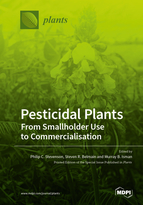Pesticidal Plants: From Smallholder Use to Commercialisation
A special issue of Plants (ISSN 2223-7747).
Deadline for manuscript submissions: closed (31 December 2019) | Viewed by 56176
Special Issue Editors
2. Royal Botanic Gardens, Kew TW9 3AB, UK
Interests: optimising pesticidal plants; chemical ecology; pollinator biology and health
Special Issues, Collections and Topics in MDPI journals
Interests: optimization pesticidal plants; rat ecology
Interests: entomology and toxicology
Special Issues, Collections and Topics in MDPI journals
Special Issue Information
Dear Colleagues,
Global perceptions about environmental damage and changes to pesticide regulations in some regions as a consequence of their environmental persistence, broad spectrum activities or non-target effects, especially in Europe, has limited the number of synthetic chemicals products permitted for use in pest control. The increasing pressure on synthetic products has reinvigorated efforts to seek alternative pest management options, including new opportunities for plant-based solutions that are environmentally benign and tailored to different farmers’ needs.
This Special Issue will capture the latest developments in research on pesticidal plants and botanical pesticides from fundamental aspects, including identification of plant chemicals and evaluation of their bioactivities against pests or pathogens, mechanisms of activity, validation of use in small-scale systems and commercial-scale pest management, including in horticulture and disease vector control. We expect contributions to be undertaken using robust approaches that use chemical analysis or other referencing data to substantiate the source and origin of plant species tested.
Prof. Dr. Philip C Stevenson
Prof. Dr. Steven R Belmain
Prof. Dr. Murray B Isman
Guest Editors
Manuscript Submission Information
Manuscripts should be submitted online at www.mdpi.com by registering and logging in to this website. Once you are registered, click here to go to the submission form. Manuscripts can be submitted until the deadline. All submissions that pass pre-check are peer-reviewed. Accepted papers will be published continuously in the journal (as soon as accepted) and will be listed together on the special issue website. Research articles, review articles as well as short communications are invited. For planned papers, a title and short abstract (about 100 words) can be sent to the Editorial Office for announcement on this website.
Submitted manuscripts should not have been published previously, nor be under consideration for publication elsewhere (except conference proceedings papers). All manuscripts are thoroughly refereed through a single-blind peer-review process. A guide for authors and other relevant information for submission of manuscripts is available on the Instructions for Authors page. Plants is an international peer-reviewed open access semimonthly journal published by MDPI.
Please visit the Instructions for Authors page before submitting a manuscript. The Article Processing Charge (APC) for publication in this open access journal is 2700 CHF (Swiss Francs). Submitted papers should be well formatted and use good English. Authors may use MDPI's English editing service prior to publication or during author revisions.
Keywords
- plant chemical analysis
- field evaluation of pesticidal plants
- crop productivity
- botanical pesticides
- pest management
- commercialization of botanicals









